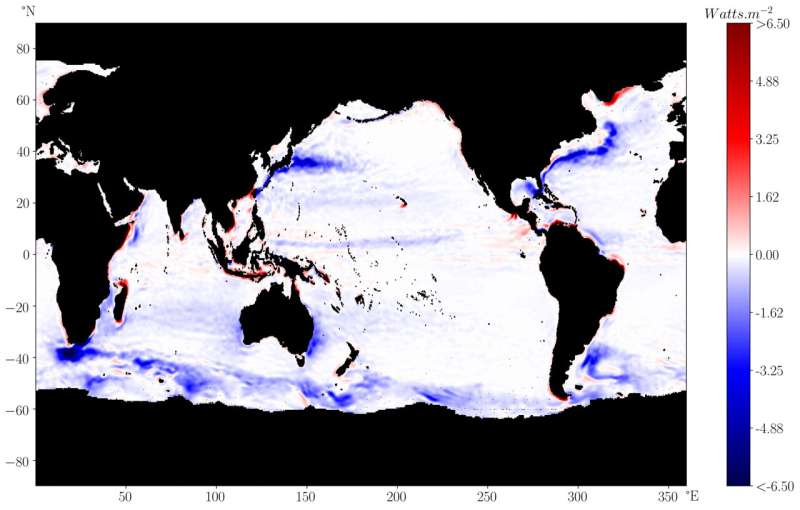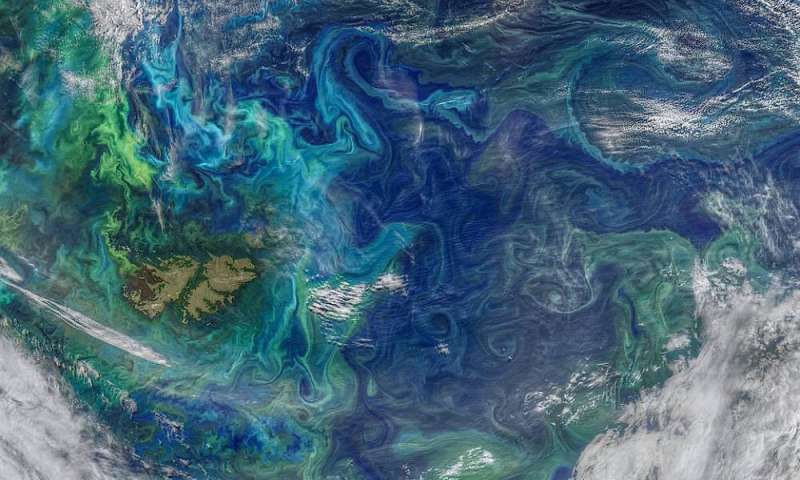Effect of 'eddy killing' in oceans is no longer a matter of guesswork

Ocean currents, propelled by kinetic energy from the wind, are the great moderators of our climate. By transferring heat from the equator to polar regions, they help make our planet habitable.
And yet, the large-scale models used by scientists to study this complex system fail to accurately account for the impact of wind on the ocean's most energetic components: Swirling, mesoscale eddies. These circular currents of water 50 to 500 kilometers in size are critical to determining the trajectory of larger ocean currents like the Gulf Stream.
In a paper in Science Advances, researchers from the University of Rochester and Los Alamos National Laboratory document for the first time how the wind, which propels larger currents, has the opposite effect on eddies less than 260 kilometers in size—resulting in a phenomenon called "eddy killing."
They also provide the first direct measurement of the overall impact of this eddy killing: A continual loss of 50 gigawatts of kinetic energy—equivalent to the detonation of a Hiroshima nuclear bomb every 20 minutes, year-round.
Better analysis with satellite observations
"For the first time we are able to unravel eddy killing by direct measurement from satellite observations, with minimal assumptions," says corresponding author Hussein Aluie, associate professor of mechanical engineering at Rochester.
The team—which also includes Shikhar Rai, a Ph.D. student in Aluie's Turbulence and Complex Flow Group, and Los Alamos National Laboratory scientists Matthew Hecht and Matthew Maltrud—applied a coarse-graining approach to satellite imagery. Doing so allowed them to separate the complex, multiscale structures of ocean currents and eddies embedded within each other.
This method provides a more detailed spatial analysis than is possible with the ones used by most oceanographers, which concentrate on temporal fluctuations, Aluie says. Those methods either fail to account for the impact of eddy killing or provide wildly varying estimates. "The numbers have been all over the place," Aluie says.
Aluie praised Rai, a fifth-year Ph.D. student, for doing "all the heavy lifting" for the paper. "There were many technical issues, but he persevered and was able to figure them out," Aluie says. "He's got a lot of promise and talent."

New method could turn the tide for studies of ocean currents
Scientists have known about eddy killing since the late 1980s from idealized models, Aluie says.
The basic concept is fairly simple to visualize. An eddy is like a circle rotating either clockwise or counterclockwise. Any wind flowing over the eddy, however, will be moving in only one direction, "helping" the half of the circle moving at least partly in the same direction, while impeding the other half.
Imagine riding a bicycle alongside a car going in the same direction—much like the wind flowing over the part of the eddy moving in the same direction. The difference in velocity is proportionately much less than occurs when you bike past a car moving in the opposite direction, much like the wind pushing against the other side of the eddy. That difference in proportional velocity accounts for the net "killing" effect on the eddy, resulting in the wind extracting energy.
"On the one hand the wind is making the ocean move, and yet it is killing the part of it that is the most energetic. So, it is counterintuitive and something that had not been directly measured before because people were using the wrong tools," Aluie says.
A better tool is important because many questions remain about other factors that may influence eddy killing, and about the importance of eddies in other aspects of the ocean's currents, heat flow, salt concentrations, and upwelling of nutrients and marine organisms, he says.
The method demonstrated in this paper will hopefully be adapted by oceanographers to "unravel" these mysteries as well, Aluie says.Proposed set of conservation laws find order in the chaos of turbulence
More information: Shikhar Rai et al, Scale of oceanic eddy killing by wind from global satellite observations, Science Advances (2021). DOI: 10.1126/sciadv.abf4920
Journal information: Science Advances
Provided by University of Rochester
No comments:
Post a Comment